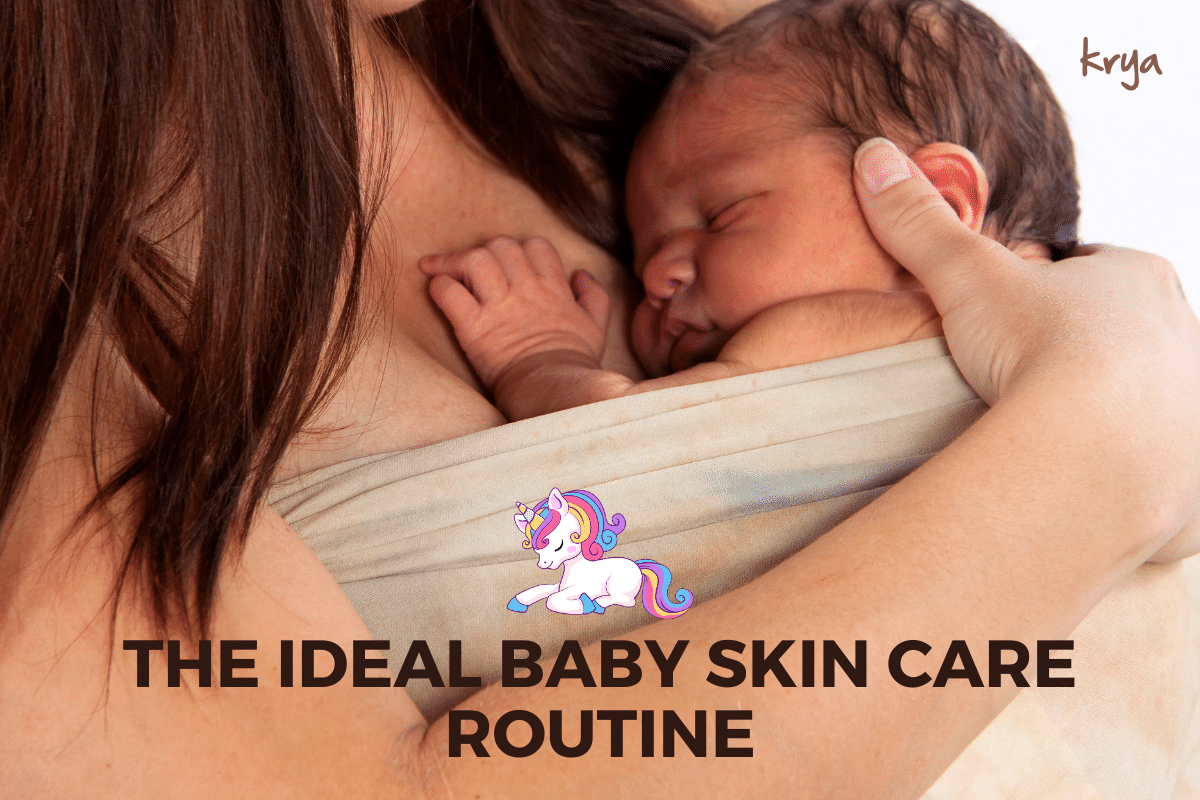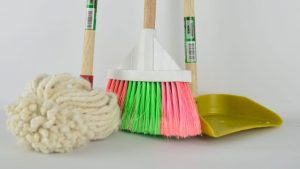This post was last updated on August 12, 2021 by Preethi Sukumaran
Last fortnight we looked at the horrors of disposable diapers for the baby and mother earth.
A quick summary of the inconvenient facts are:

and

For the longer version, please read the original blog post here.
For those struck with a mixture of guilt and hopelessness, hope still waits, in the form of cloth diapers, both ancient and modern.
In a cradle to grave study sponsored by the National Association of Diaper Services (U.S), it was found that disposable diapers produce seven times more solid waste when discarded and three times more solid waste during the manufacturing process, when compared modern cloth diapers (MCD).
When MCDs are used for the baby, solid waste (poop) is flushed down the toilet and not dumped in a landfill, waste is being sent down the right channel preventing water and earth contamination.
The health benefits for a baby put on cloth diapers are numerous.
Cloth diapering depends only on the absorbency of the material used to contain the baby’s waste output and not on uninvestigated, potentially hazardous substances like Sodium Polyacrylate ( the super absorbent polymer , SAP) used in disposable diapers.
Cloth diapers are said to facilitate early toilet training as compared to disposables by achieving the right balance between keeping the baby dry and letting him / her know when it is time to change the diaper. Unlike a disposable, a cloth diaper is never completely dry when full. The feeling of dampness alerts the baby, who becomes sensitized to the idea of a diaper change,
By avoiding all the hazardous substances that go into a disposable diaper which can trigger contact dermatitis and rashes and by alerting the baby’s caregiver to a nappy change, cloth diapered babies are in general less rash prone.
Ok I’m sold; What are my cloth diaper options?
Cloth diapering has really come into its own now, and brands offer a huge array of diapering options, which in itself could be the subject of a blog post. I am going to simply outline the options below – in case of further questions please write to me or research the links I have given below.
Please keep in mind that my experiences with different cloth diaper brands are with a sample size of 1, my daughter. You might find that your experiences with the brands I’ve described may vary.
1. Flats or cotton nappy squares ( Ancient Cloth Diapers)
Flats are the simplest and most “ancient” form of diapering. These squares of fine cotton cloth can be folded in particular ways to increase absorbency. They can be fitted directly on the baby using a diaper pin or under a cloth / waterproof plastic nappy.
Despite many technological advances, these simple old fashioned nappy squares are the easiest to care for, extremely economical, and are the healthiest for baby’s skin. Unfortunately, their absorbency is not very high, so they require a lot of effort on the part of the caregiver in changing them frequently.
A quick fix for those who want to continue using these cotton squares is to purchase the outer waterproof cover described in # 2 below and used them in combination.
2. Re-usable cover with inserts
This is a modern cloth diaper with an outer waterproof layer made of TPU and an insert that works well to absorb liquid and contain any accidents. The inserts when soaked through should be thoroughly laundered and sun-dried. The outer cover can be reused after a wipe with fresh inserts.
This is a convenient, cost effective solution for moms wanting to explore the world of cloth diapering, and works as well as disposable diapers depending on the baby’s output volume.
In India, 2 companies offer this solution (at the time of writing this article, February 2013)
Bum Chum reusable cloth diapers offers a variant called Bum Chum Cowboy: the outer cover comes in cute prints and the inner insert uses a combination of bamboo and microfiber.
The cowboy cover comes with 2 snaps at the back and a wide band of elastic in the front that holds the insert in place so that it does not shift when the baby is crawling or walking.

The second company is called Smart baby who are the distributors of Cotton Babies U.S and offer a variant called Flip in this type of diaper. The Flip cover is a TP waterproof cover and comes with a choice of an organic cotton insert or a microfiber insert.

The Flip comes with a stay-dry insert which has a suede-like finish on the side that comes in contact with the baby and the other side is made of microfibre. This stay-dry insert works very well. Of course, micro fibre is a man made fabric, which should not be placed next to baby’s skin, which is why the stay dry layer is made of a different material. Microfibre in comparison to plain cotton dries much faster, but in long term use can have more build up and therefore has a slightly shorter life span.
Another insert option in the Flip is the organic cotton insert. The cotton insert is similar to the flats we discussed earlier. The advantage of this kind of insert is that is it is much better for baby’s skin. The disadvantage is the same as flats: its absorbency is not very high, compared to the microfiber insert which means that the caregiver needs to change this constantly.
For our baby, we use reusable cover systems from both Bum Chum and Smart baby. I find these kinds of diapers perfect for daytime use where you are not looking for a huge amount of absorbency, and want a system that is easy to change and launder. The re-usable outer cover can be washed very easily by hand, and dries very quickly, making it easy to use it with another insert.
3. Pockets and All in One diapers:
Pocket and all in one diapers offer much better absorption and are a good option for night time diapering.
This type of diaper comes with a waterproof cover and an inner fleece / suede cloth layer that touches the baby and keeps her dry. The diaper has an opening at the back through which you can stuff absorbent layers inside like a pocket.
Depending on how heavy a wetter the baby is, you can choose microfibre, hemp or bamboo inserts and use 2 – 3 to increase the diaper’s absorbency.
I have found pockets to work anywhere from 6 hours to 12 hours depending on the season, the baby’s output and the number of inserts used. Once full, the inserts and the cover need to be washed.
All in ones are a variant of the pocket, where instead of stuffing the inserts, the inserts come pre stitched, so it can be put on and removed like a disposable without any insert stuffing or adjustments. These diapers work especially well when caregivers are new to cloth diapering. However, I have found them slightly trickier to launder compared to a standard pocket, and prefer the pocket where the inserts and cover can be detached from each other.
Bum Chum offers Bum Chum fitteds which are pocket diapers.

Smart baby offers Bum Genius pocket diapers and Bum Genius Freetime which is an All in One.

Both brands offer an option of buying extra inserts to use for night time doubling.
Smart baby offers hemp doublers which can increase absorbency if stuffed between microfiber inserts. Bum Chum offers a bamboo microfiber insert, which can also be used for extra absorbency. The hemp doubler is very slim, and can be easily stuffed into brands with smaller pocket openings like Bum Chum.
With some trial and error, both brands have worked for us for night time diapering.
Both brands offer snap options to customise the diaper’s fit for different sized babies and can be used from birth upto potty training.
The Economics of MCDs
All the MCD variants come with a variable fastener, which means that their size can be adjusted to the size of the growing baby. MCDs can be used from birth till the baby is toilet trained.
To ensure that your baby is only diapered with MCDs, you would need to purchase at least 15-20 units (with a mix of day-time and night-time diapers). These 15-20 units would be adequate for a 3-day cycle of diapering for the baby. At the end of the day 2, all the soiled covers and inserts should be laundered, so that they get all of day 3 to dry in the sun and would be ready to commence yet another 3 day cycle.
A complete set of MCDs represent an upfront, one-time investment of Rupees twenty thousand or above depending on the brand purchased. In part one of this post we saw that on a conservative estimate a baby will run through 5000 disposable diapers by age two. This represents an outflow of at least Rupees sixty thousand at today’s prices. Considering that disposable diapers use crude oil as the raw material, their price could go up sharply. On the other hand if you purchase a complete set of MCDs upfront, you are insured against price inflations. Further, when MCDs are well taken care of, they can be reused for the next baby as well.
Then again there is a secret option B for those who have a Do-It-Yourself (DIY) bent of mind.
A chance conversation with talented food blogger, Chinmayie Bhat, led me to a whole new world of DIY cloth diapering. For those who have read Chinmayie’s blog, it should come as no surprise that she made a very good looking stash of cloth diapers herself to add to her MCD stash, with absorbent materials found at home like t-shirts.
The diapers Chinmayie made for her daughter are great pocket options, offering all the convenience of MCDs , with a little less absorbency which can be improved if you add some of the soakers we discussed above, but are practically free.
Here are some pictures:


Starter Links to hand sew your own pocket diapers are given in the resources section.
Caring for your cotton flats and MCDs
A natural soapberry based detergent like Krya, is an excellent product to help take care of your cloth flats and diapers and make them last longer. If laundered properly, cloth flats and MCDs are as hygienic as disposable diapers and smell clean and fresh after each wash.
Important points to keep in mind when caring for cloth nappies and MCDs:
- Cloth flats and nappies should be washed as soon as possible. Pee stains when allowed to sit in permanently stain the cloth yellow. If you plan to wash them every other day, store dry, until the morning of your wash.
- Do not wash modern cloth diapers along with cloth nappies. Modern cloth diapers use man made fabrics like micro fibre, and the outer cover uses TPU. When washed along with natural textiles like cotton, the lint tends to stick to these manmade fabrics. In time you might find that your inserts are not absorbing liquids as well as they should be.
- Always do a pre-wash routine with cloth flats / nappies and MCDs (modern cloth diapers). This is essential to remove the soaked urine in the diapers completely.
- Time your laundry so that your cloth nappies, flats and diapers get a chance to get thoroughly sun dried. The sun will remove any lingering smells and lighten stains in case you haven’t managed to catch it early.
- Nappies and Inserts should be flat dried whenever possible in the sun for maximum anti bacterial action. If they are dried slowly (morning sun to the evening sun) they will retain their softness and feel fluffy wash after wash.
Proper care for your MCDs is vital to ensure that they perform well for a long time and deliver a great return on your investment. Therefore we have created a detailed graphical guide, the Krya guide to washing MCDs. The link to download the guide is at the end of this article.
Don’t Panic
If you are concerned about the wide array of diapering options, their care or the upfront costs involved, we have two words for you.
Don’t Panic.
Start with a few MCDs, perhaps one each of day and night time variants. Give it a try and check if you and your baby are happy with the results. Then you could dive right in. We would be happy to share our experience with cloth diapering to help you in your journey. And you get a halo for being an environmental champion.
Click here for the graphical guide. As always: Please download, try, reflect and share.
Resources
- Learn more about Bum Chum cloth diapers here
- Learn more about Smart baby cloth diapers here
- You can purchase MCDs at your local baby essentials store. In Chennai we were introduced to the parallel universe of MCDs by the fine folks at Pappadum
- We would like to thank Bum Chum & Smart baby for permission to use their images.
- We would like to specially thank talented food blogger and photographer Chinmayie Bhat for introducing us to her world of hand stitched, colourful DIY diapers. Chinmayie writes an eclectic, and interesting food blog called Love Food Eat, which is a must read.
- Here are some starter links that Chinmayie shares on how to make your own cloth diapers. As always these are to help you get started on this journey. Further reading and research will throw up more such resources.
- http://www.youtube.com/watch?v=sh84LK19VNE
- http://www.pennilessparenting.com/2011/03/cloth-diapering-for-penniless-parents.html
- p.s: The name of this blog is derived from the blogger’s name, Penny.





I was waiting for this from the time I read your earlier post! Thanks. Sharing.
🙂 I’m glad! Thank you!
Hi Preethi,
could you pls post the source link of the chinmayee’s diaper photos you posted? I tried to search it out on her blog, but couldnt find any..
Do you have any environmentally friendly solutions for wipes as well? I try to use cloth wipes as much as possible but it’s hard to do when I step out of home. What do you do for your daughter?
Good point – I have used cloth wipes dipped in a simple soapberry+chamomile+lavender essential oil solution that I made or just plain water. Haven’t been able to completely move myself away from disposable wipes for my daughter as yet – have resolved to do so from now onwards. Thank you for stopping by!